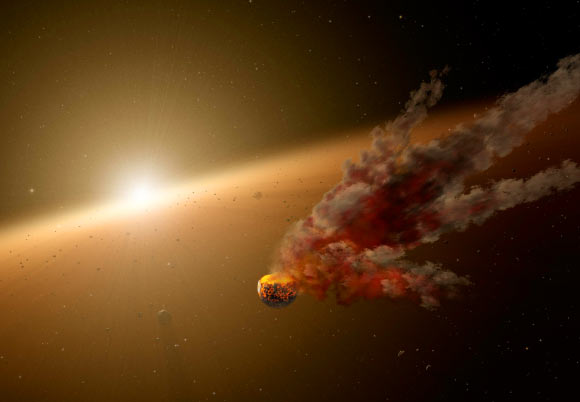KIC 8462852, a main-sequence star in the constellation Cygnus, roughly 1,480 light-years away, has been in the news during the past year.
In September 2015, Yale astronomer Tabetha Boyajian and co-authors announced that KIC 8462852 underwent a series of brief, non-periodic dimming events while it was being monitored by NASA’s Kepler space telescope.
Speculation to explain KIC 8462852’s dips in brightness has ranged from a swarm of extrasolar comets or planetesimal fragments orbiting the star to a so-called Dyson sphere, a hypothetical energy-gathering structure built around the star.
A new study, by Dr. Joshua Simon from the Observatories of the Carnegie Institution of Washington and Dr. Benjamin Montet from the California Institute of Technology and the Harvard-Smithsonian Center for Astrophysics, has deepened the mystery.
The authors analyzed further Kepler observations of KIC 8462852 (also known as TYC 3162-665-1 and 2MASS J20061546+4427248) and showed that in addition to its rapid unexplained brightness changes, the star also faded slowly and steadily during the four years it was observed by Kepler.
“We thought that these data could confirm or refute the star’s long-term fading, and hopefully clarify what was causing the extraordinary dimming events observed in KIC 8462852,” Dr. Simon said.
The team found that, over the first 1,000 days of the Kepler mission, KIC 8462852 faded approximately linearly at a rate of 0.341% per year, for a total decline of 0.9%.
The star then dimmed much more rapidly in the next 200 days, with its brightness dropping by more than 2%.
For the final 200 days the magnitude remained approximately constant, although the Kepler data are also consistent with the decline rate measured for the first 2.7 years.
The astronomers then compared this with 548 similar stars observed by Kepler and found that a small fraction of them showed fading similar to that seen in KIC 8462852 over the first three years of Kepler images. However, none exhibited such a dramatic dimming in just six months, or a total change in brightness of 3%.

KIC 8462852 (center). Image credit: Centre de Données astronomiques de Strasbourg / SIMBAD.
“The steady brightness change in KIC 8462852 is pretty astounding. Our highly accurate measurements over four years demonstrate that the star really is getting fainter with time,” Dr. Montet said.
“It is unprecedented for this type of star to slowly fade for years, and we don’t see anything else like it in the Kepler data.”
“KIC 8462852 was already completely unique because of its sporadic dimming episodes,” Dr. Simon said.
“But now we see that it has other features that are just as strange, both slowly dimming for almost three years and then suddenly getting fainter much more rapidly.”
The scientists think that the best proposal so far for explaining the star’s six month dimming might be a collision or breakup of a planet or comet in the star’s system, creating a short-term cloud of dust and debris that blocks some starlight.
However, this wouldn’t explain the longer-term dimming observed during the first three years of the Kepler mission and suggested by measurements of the star dating back to the 19th century.
“It’s a big challenge to come up with a good explanation for a star doing three different things that have never been seen before,” Dr. Montet said.
“But these observations will provide an important clue to solving the mystery of KIC 8462852.”
The team’s findings have been accepted for publication in the Astrophysical Journal Letters. The article is also publicly available at arXiv.org.
Source: Sci News

































Leave a Comment
You must be logged in to post a comment.